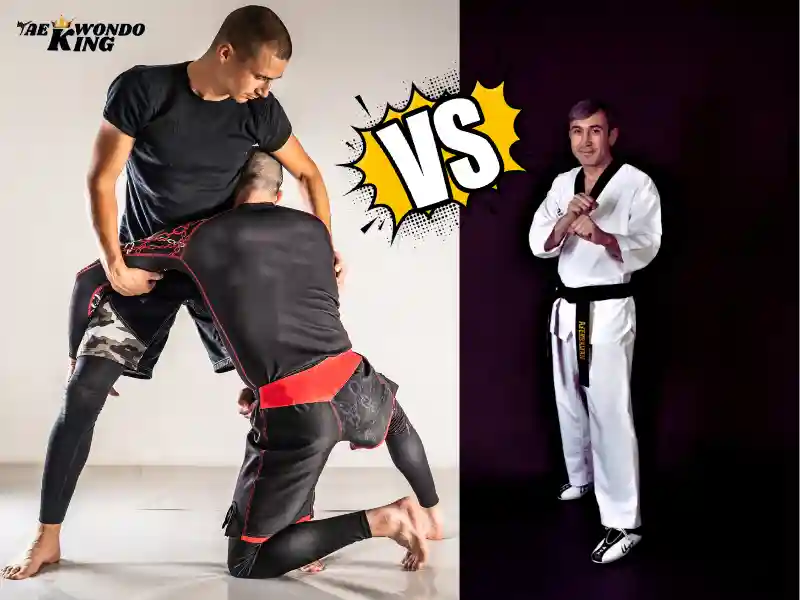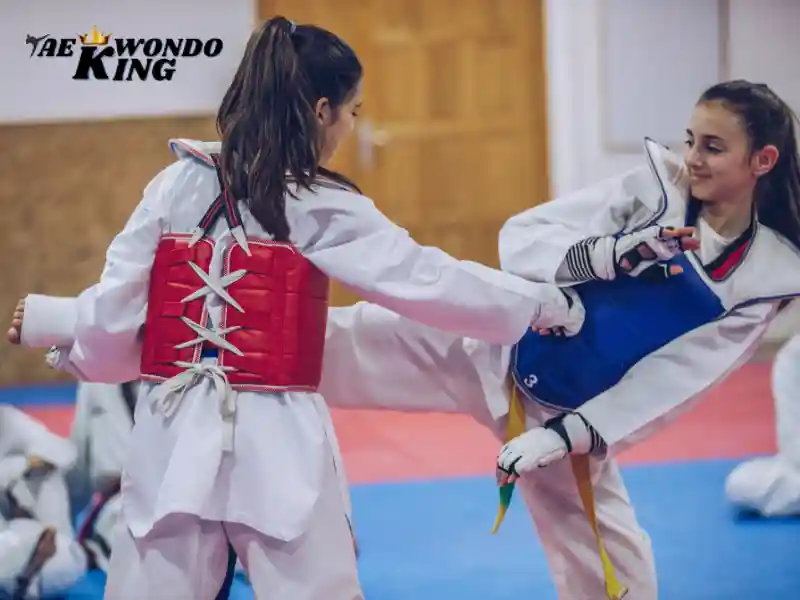
The world of martial arts is a diverse and captivating realm rich with traditions, philosophies, and techniques. Within this realm, Brazilian Jiu-Jitsu (BJJ) and Taekwondo have earned their rightful places as two prominent disciplines, each embodying distinct approaches to combat and self-mastery. As enthusiasts and practitioners ponder the outcome of a martial arts showdown, a thought-provoking question arises: Does Brazilian Jiu-Jitsu truly outshine Taekwondo? BJJ Beat Taekwondo? This article embarks on a journey to dissect the intricacies within BJJ and Taekwondo, exploring their strengths, strategies, and applications to uncover the truth behind this intriguing comparison.
It is a good idea to choose one martial art. You can combine different styles of martial arts for the best results. Many people in the world practice more than one style of martial arts. For example, some people practice a few types of martial arts. They might do taekwondo in the morning, and in the afternoon, they do karate. Others may practice boxing, MMA, Muay Thai, and Brazilian Jiu-Jitsu (BJJ). They try to keep in shape with different types of exercise. The article helps you to learn about the origin, history, philosophy, rules, similarities, differences, pros, and cons of both Brazilian Jiu-Jitsu and Taekwondo.
Background: BJJ and Taekwondo

Brazilian Jiu-Jitsu (BJJ):
Brazilian Jiu-Jitsu (BJJ) boasts a captivating history that traces back to its roots in Japanese Jiu-Jitsu and Judo. In the early 20th century, Japanese Jiu-Jitsu master Mitsuyo Maeda migrated to Brazil, sharing his knowledge with Carlos Gracie. The Gracie family refined and adapted these techniques, giving birth to Brazilian Jiu-Jitsu. Focused on ground-based grappling and submissions, BJJ gained attention through its effectiveness in mixed martial arts (MMA) competitions.
The art’s evolution continued as practitioners tested and refined techniques, leading to a dynamic martial art that prioritizes technique, leverage, and strategy. Today, BJJ stands as a renowned and integral part of the martial arts landscape, exemplifying the beauty of adaptation and innovation.
Taekwondo:
Taekwondo’s origins can be traced to Korea’s ancient martial arts, but its modern history began in the mid-20th century. Influenced by indigenous Korean styles and Japanese martial arts, Taekwondo was officially named in the 1950s. It gained global recognition and acceptance as an Olympic sport, showcasing its dynamic kicks and techniques. Key figures like General Choi Hong Hi played vital roles in shaping its philosophy and curriculum.
Taekwondo’s journey reflects Korea’s martial heritage and its evolution into a competitive and disciplined martial art. Today, Taekwondo is practiced worldwide, celebrated for its unique blend of tradition, athleticism, and self-defense techniques.
Analyzing the Attributes: BJJ vs Taekwondo
Techniques and Range:
- BJJ: BJJ shines in ground grappling, emphasizing positional control and submission techniques. It excels at close-quarters combat and utilizes leverage and technique to neutralize opponents.
- Taekwondo: TKD is a stand-up striking art, concentrating on powerful kicks, punches, and blocks. Its focus on distance and dynamic movement allows practitioners to engage opponents from afar. A Taekwondo fighter must know how to differentiate between right and wrong.
Strategy and Tactics:
- BJJ: BJJ employs a tactical approach, aiming to control and submit opponents by utilizing proper positioning and leveraging an opponent’s force. It emphasizes patience, transitions, and submission setups.
- Taekwondo: Taekwondo’s strategy centers on utilizing speed, flexibility, and precision to overwhelm opponents with fast, punches, and powerful strikes. Techniques are often executed in quick succession to create openings.
Real-World Application:
- BJJ: BJJ is highly effective in one-on-one confrontations, particularly in situations where ground control and submissions are necessary. It may have limitations against multiple attackers or armed opponents. A jiu-jitsu fighter can easily dominate an attacker in a street fight.
- Taekwondo: Taekwondo equips practitioners with dynamic striking techniques suitable for self-defense scenarios. Its emphasis on maintaining distance and delivering powerful kicks can be effective in warding off threats.
Physical Fitness and Conditioning:
- BJJ: BJJ offers rigorous cardiovascular training through sparring and grappling sessions, enhancing muscular endurance, core strength, and flexibility.
- Taekwondo: Taekwondo training incorporates intense cardiovascular workouts, flexibility exercises, and explosive movements, promoting agility, balance, and overall fitness.
Complementary Aspects: BJJ and Taekwondo
Instead of viewing BJJ and Taekwondo as adversaries, BJJ Beat Taekwondo? it’s essential to recognize their potential for synergy and mutual enrichment.
Versatility and Range Management:
- BJJ: Integrating Taekwondo’s striking techniques can enhance a BJJ practitioner’s stand-up capabilities, allowing them to manage distance, deliver strikes, and set up takedowns.
- Taekwondo: Learning BJJ can provide TKD practitioners with ground skills, enabling them to defend against takedowns, escapes, and submissions.
Adaptability and Decision-Making:
- BJJ: Taekwondo’s dynamic strategy can foster adaptability and quick decision-making in BJJ practitioners, enhancing their ability to transition between techniques and adapt to changing situations.
- Taekwondo: BJJ’s emphasis on tactical positioning can enhance the strategic mindset of Taekwondo practitioners, allowing them to recognize opportunities and adjust techniques effectively.
Mind-Body Connection:
- BJJ: The controlled and methodical nature of BJJ can enhance a practitioner’s body awareness, balance, and sensitivity to an opponent’s movements.
- Taekwondo: Taekwondo’s focus on explosive techniques can contribute to a practitioner’s overall athleticism, speed, and reflexes.
Which Martial Art is superior, BJJ or Taekwondo?
It is subjective to determine which martial art is superior as it depends on personal preferences, goals, and individual skill levels. Brazilian Jiu-Jitsu (BJJ) focuses on ground fighting, grappling, and submissions, while Taekwondo emphasizes kicks, strikes, and self-defense techniques. Both martial arts have their strengths and weaknesses, so it is recommended to try out different styles and see which one suits you best.
What are the pros and cons of BJJ in comparison to Taekwondo?
Pros of Brazilian Jiu-Jitsu (BJJ):
1. Focus on ground fighting and grappling techniques.
2. Effective for self-defense, especially in close-quarter combat.
3. Emphasizes technique and leverage over strength, making it suitable for people of all sizes and genders.
4. Provides a great workout and improves cardiovascular fitness.
5. Builds discipline, patience, and mental resilience.
Cons of Brazilian Jiu-Jitsu (BJJ):
1. Limited emphasis on striking techniques, which may be a disadvantage in stand-up fighting scenarios.
2. Can be physically demanding and may lead to injuries, particularly on joints and muscles.
3. Long learning curve before becoming proficient in techniques.
4. Less emphasis on traditional martial arts values and philosophies.
Pros of Taekwondo:
1. Focuses on high, fast kicks and dynamic footwork.
2. Develop flexibility, strength, and agility.
3. Promotes discipline, self-control, and respect for others.
4. Offers effective self-defense techniques, especially in stand-up fighting.
5. Provides opportunities for competition and sport.
Cons of Taekwondo:
1. Limited emphasis on ground fighting and grappling techniques.
2. Dependent on speed and agility, which may be challenging for individuals with physical limitations.
3. Less focus on practical self-defense techniques for real-life situations.
4. Can be more rule-based and less applicable in real-life self-defense scenarios.
It’s important to note that the pros and cons listed above are general observations and may vary depending on individual goals, preferences, and training methodologies within each martial art.
Who has the advantage: BJJ or Taekwondo?
In most real-fight scenarios, BJJ generally has the upper hand over Taekwondo. Here’s why:
- Grappling vs. Striking: BJJ excels at grappling and ground fighting, taking the fight to a place where Taekwondo’s powerful kicks are less effective.
- Closing Distance: BJJ techniques focus on clinching and takedowns, effectively neutralizing a Taekwondo practitioner’s kicking range.
- Limited Ground Defense: Traditional Taekwondo has less emphasis on ground fighting, making it harder to defend against BJJ’s grappling dominance.
How can someone succeed in Brazilian Jiu-Jitsu and Taekwondo?
To succeed in Brazilian Jiu-Jitsu and Taekwondo, it is important to follow these tips:
1. Find a reputable and experienced instructor: Look for a qualified instructor who can provide proper guidance and training in both disciplines.
2. Practice regularly: Consistent practice is key to improving your skills and techniques. Make sure to attend classes regularly and dedicate time to individual training.
3. Set specific goals: Define your goals and work towards achieving them. Whether it is mastering a certain technique or earning a higher belt rank, having clear objectives will help you stay motivated and focused.
4. Develop a strong foundation: Focus on building a solid foundation in the fundamental techniques of both Brazilian Jiu-Jitsu and Taekwondo. This will provide a strong base upon which you can further develop your skills.
5. Be patient and persistent: Progress in martial arts takes time and effort. Stay committed, be patient with yourself, and don’t get discouraged by setbacks or slow progress.
6. Cross-train: While specializing in one martial art is important, cross-training can be beneficial. Incorporating elements from one discipline into the other can enhance your overall skill set and understanding.
7. Stay physically fit: Conditioning and flexibility are crucial for both Brazilian Jiu-Jitsu and Taekwondo. Regular exercise, strength training, and stretching will improve your overall performance.
8. Have a positive mindset: Cultivate a positive attitude, embrace challenges, and learn from failures. A positive mindset will help you stay motivated and resilient in your martial arts journey.
9. Respect and uphold martial arts values: Honor the traditions, ethics, and values of both Brazilian Jiu-Jitsu and Taekwondo. Show respect to your instructors, training partners, and opponents, and always strive for personal growth and self-improvement.
In a self-defense situation, which is generally more effective, BJJ or Taekwondo?
In most real-world scenarios, Brazilian Jiu-Jitsu (BJJ) is considered more effective than Taekwondo for self-defense. Here’s why:
- Focus on Grappling: BJJ excels at grappling and ground fighting, which are common outcomes in street fights. Taekwondo primarily focuses on kicks, which can be less effective if the fight goes to the ground.
- Defense Against Strikes: BJJ equips you with techniques to defend against takedowns and control your opponent on the ground, minimizing the advantage of Taekwondo’s kicks.
- Limited Space Applicability: BJJ is effective even in confined spaces, unlike Taekwondo kicks that require some distance.
BJJ Beat Taekwondo? Who is better to learn?

Whether Brazilian Jiu-Jitsu beats Taekwondo transcends a simple verdict and delves into the realm of context and application. How is BJJ Beat Taekwondo? Both disciplines possess unique strengths that can be harnessed effectively based on the situation at hand. BJJ’s ground control and submission techniques excel in close-quarters combat and one-on-one scenarios, while Taekwondo’s explosive striking techniques are potent tools for maintaining distance and delivering powerful attacks. Taekwondo and BJJ have a lot of benefits and a lot of rules. Jiu-jitsu focuses on ground fighting whereas Taekwondo is attacking opponent on their feet.
Rather than seeking a definitive winner, it’s imperative to recognize the potential harmony between BJJ and Taekwondo. By combining the strengths of both disciplines, martial artists can embark on a holistic journey toward mastery, transcending the boundaries of a single art. The Kukkiwon and World Taekwondo (WT) Headquarters also awards black belts to taekwondo fighters.
The pursuit of martial excellence isn’t about pitting one art against another; it’s about embracing the interconnectedness of these disciplines to create a well-rounded martial artist equipped to navigate a myriad of combat scenarios. Instead of asking whether BJJ beats Taekwondo, let us explore how these arts can coexist harmoniously, enriching our martial arts journey and unlocking a realm of potential that spans beyond any single discipline.
FAQs
Can Brazilian Jiu-Jitsu defeat Taekwondo in a fight?
The outcome of a fight between Brazilian Jiu-Jitsu and Taekwondo would depend on various factors, including the skill and experience of the individuals involved. Dose BJJ Beat Taekwondo? Brazilian Jiu-Jitsu focuses on ground fighting, submissions, and grappling techniques, while Taekwondo emphasizes high kicks, quick strikes, and fast footwork. Both martial arts have their strengths and weaknesses. In a real-life fight, the individual who can effectively utilize their techniques and adapt to the situation would have a better chance of success, regardless of the martial art style they practice.
Can an individual with a Taekwondo background excel in BJJ?
Yes, an individual with a background in Taekwondo can excel in Brazilian Jiu-Jitsu (BJJ). Although these two martial arts have different techniques and focus, the discipline and physical conditioning obtained from practicing Taekwondo can be advantageous when learning and mastering BJJ. Transitioning from one martial art to another may involve adapting to different strategies and grappling techniques. However, with dedication, practice, and a willingness to learn, individuals with a Taekwondo background can succeed in BJJ.
Can a Taekwondo practitioner ever defeat a BJJ opponent?
Yes, while BJJ has the upper hand, a skilled Taekwondo fighter can still win under certain circumstances:
- Maintaining Distance: If a Taekwondo fighter can keep the fight standing and land a powerful, well-placed kick before the BJJ fighter closes the distance, they could win.
- Surprise Element: A well-timed and unexpected kick can catch a BJJ opponent off guard and create an opportunity to win.
Are there situations where Taekwondo could win?
Yes, while BJJ has the upper hand in most cases, here’s where Taekwondo might have a chance:
- Open Space and Distance: If a Taekwondo fighter can maintain distance and land a well-timed, powerful kick before the BJJ practitioner closes in, it could be decisive.
- Surprise Factor: A well-placed and unexpected kick from a Taekwondo fighter could catch a BJJ practitioner off guard and potentially win the fight.
What’s the best self-defense approach?
The best self-defense is situational awareness and avoiding conflict whenever possible. However, if physical confrontation is unavoidable, a well-rounded approach that incorporates striking and grappling skills is ideal.
Should I train in both BJJ and Taekwondo?
Cross-training in different martial arts can be very beneficial. Learning BJJ’s grappling skills can complement Taekwondo’s striking power, offering a more versatile self-defense skillset.
Has there been any instance where someone has overcome a Taekwondo black belt using BJJ?
There have been cases where individuals with a black belt in Taekwondo have been defeated by individuals with skills in Brazilian Jiu-Jitsu (BJJ). BJJ is a martial art that focuses on ground fighting and submissions, while Taekwondo emphasizes striking techniques. In a real-life self-defense situation, the effectiveness of any martial art depends on factors such as the skill level, physical attributes, and strategy of the individuals involved. Therefore, someone with BJJ skills can overpower someone with a Taekwondo black belt if they can bring the fight to the ground and effectively use their grappling techniques.

Founder, Owner, and CEO of TaekwondoKing.
He is one of the top 100 martial artists in the World and among the top 20 referees in Bangladesh.
Ehatasamul Alom is an esteemed Kukkiwon Certified Taekwondo 3rd Dan Black Belt with over 15 years of experience in this dynamic martial art. Born in Rajshahi, Bangladesh, Ehatasamul’s journey with Taekwondo began at the tender age of seven. His passion led him to compete at national and international levels, where he has bagged numerous awards and honors. He is also a member of the Taekwondo National Referee Panel.
With a Bachelor’s degree in Sports Science from the prestigious Rajshahi University, Ehatasamul has a deep understanding of the technical and scientific aspects of martial arts and some other martial arts.
In 2022, Ehatasamul created the “TaekwondoKing.com” to share his knowledge, Free Resources, Values, and Real experiences. His articles focus on Taekwondo training techniques, competition strategies, Sport Products Reviews, and the art’s rich history and philosophy. He also writes about the importance of mental fortitude and discipline, key aspects of his teaching philosophy. He has already launched many sports, Taekwondo, and health-related Free online tools. His goal is to inspire both beginners and seasoned practitioners worldwide through insightful and engaging content.
If you need any help, contact Ehatasamul Alom at any time.





This article gave me a fresh perspective on Taekwondo. Keep it up! After reading it, I still have some doubts. Hope you can help me.